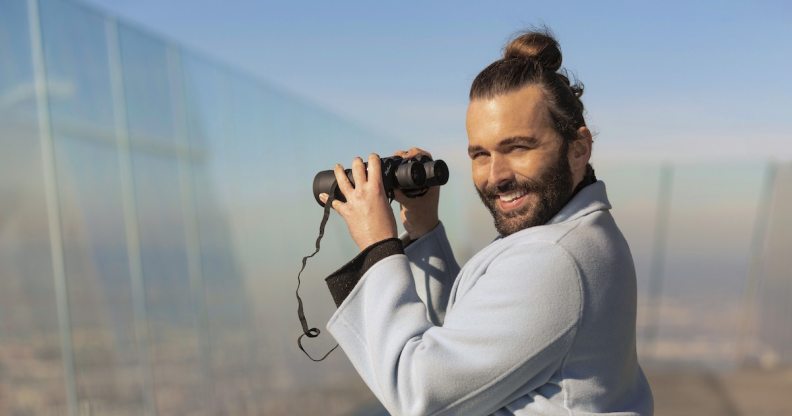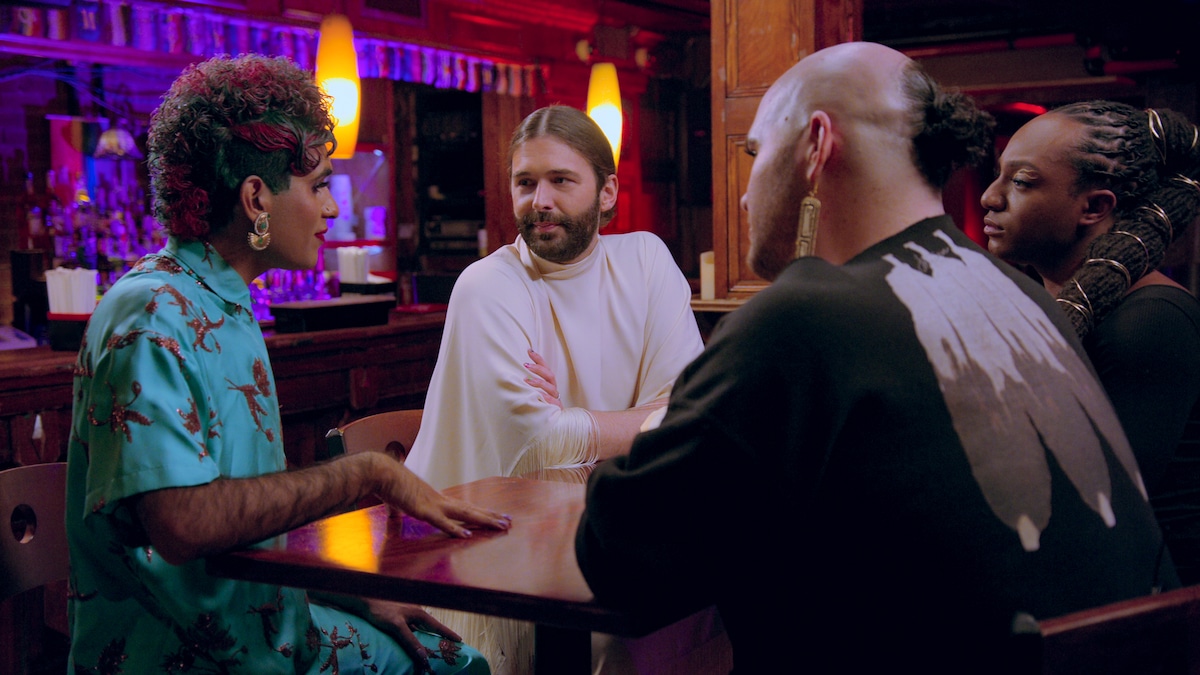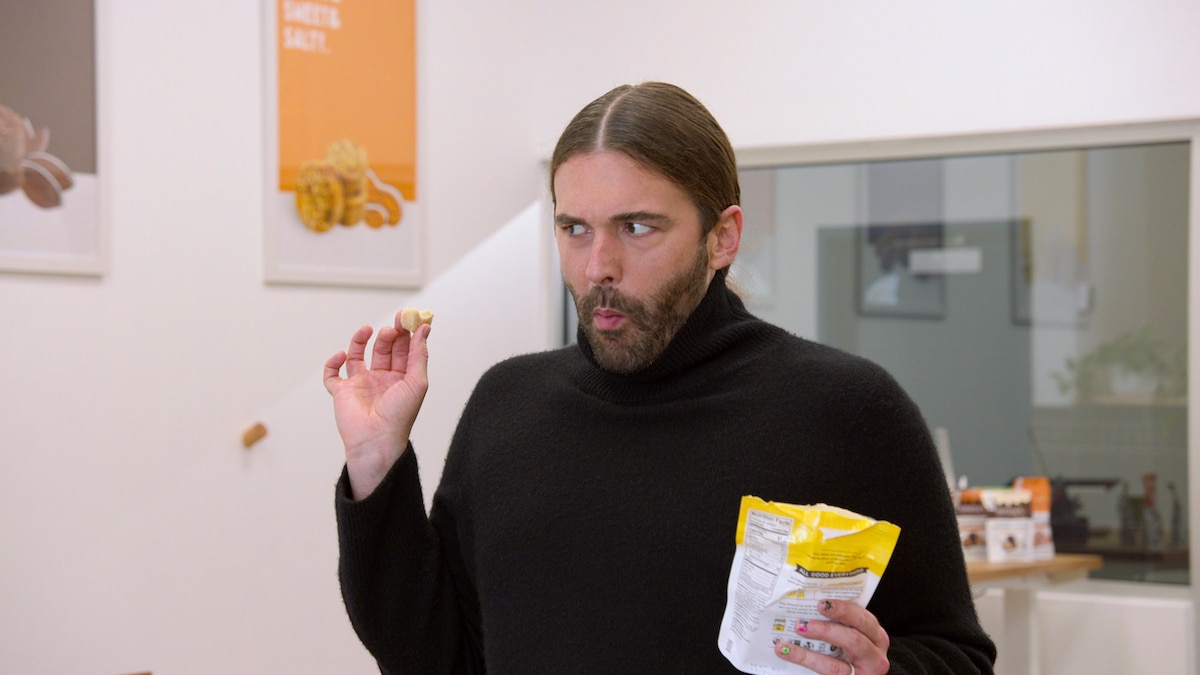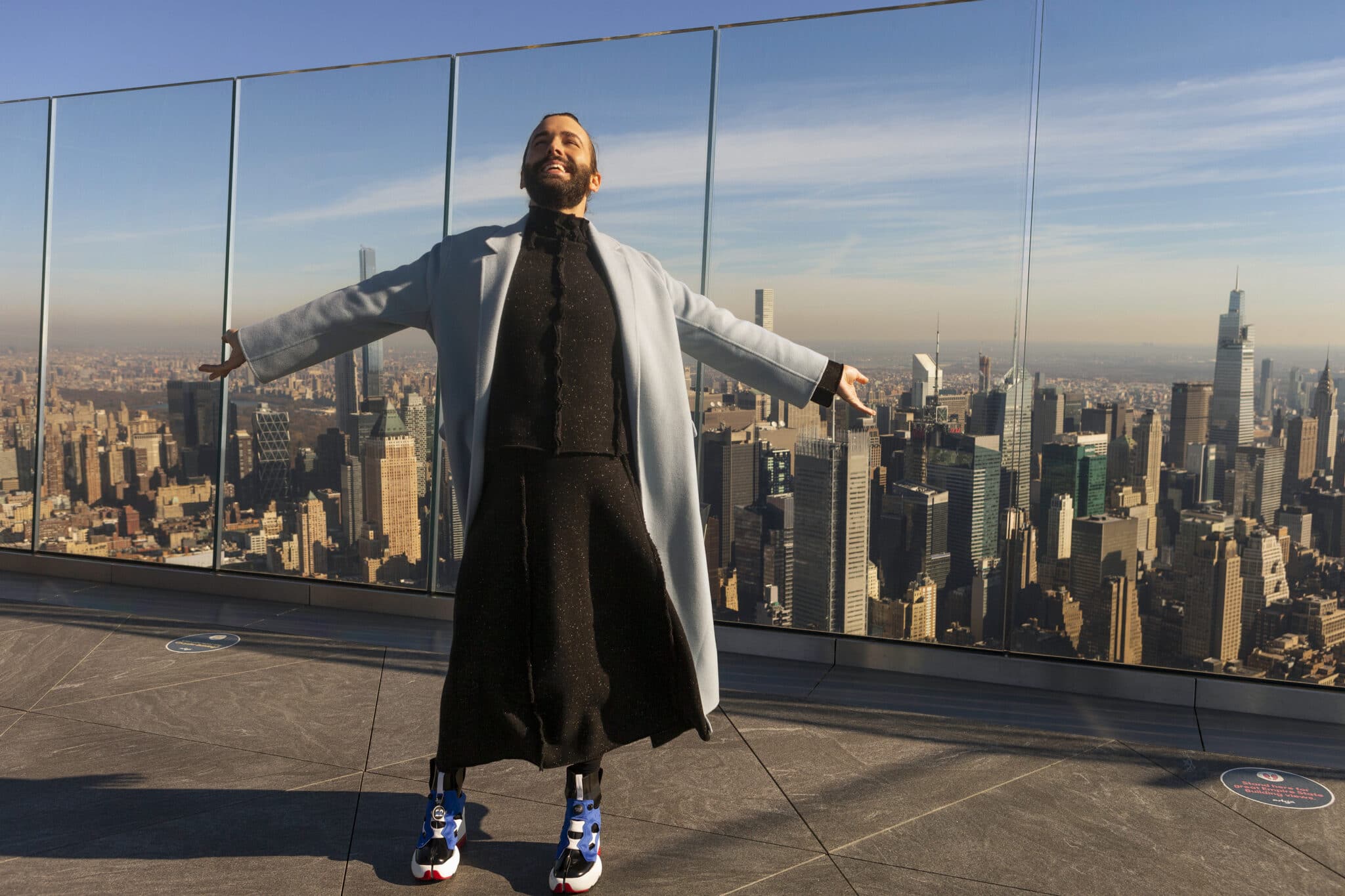Jonathan Van Ness on breaking the binary, pronouns and what cows can teach us about gender norms

Jonathan Van Ness in his new show Getting Curious with Jonathan Van Ness. (Jason DeCrown/NETFLIX)
Jonathan Van Ness in his new show Getting Curious with Jonathan Van Ness. (Jason DeCrown/NETFLIX)
Jonathan Van Ness is a little distracted when he appears on screen. He’s just stumbled upon a clip of gymnast Sunisa Lee on Instagram, and he is obsessed.
“I just made a fatal mistake of looking at my Instagram and Sunisa Lee’s new college floor routine came up,” Jonathan, who uses he, she and they pronouns, says. “I’m being such a straight man with football, wanting to watch it, but I am turning it off, I am putting it down, I will watch her collegiate floor routine a different time. That is maturity, and I’m proud of myself.”
Jonathan, or JVN as he’s affectionately known, is here to talk about his new Netflix series Getting Curious with Jonathan Van Ness. It’s a spin-off of sorts from his podcast of the same name, and it sees the Queer Eye icon exploring a variety of topics, from skyscrapers to snack foods.
There’s also a powerful, deeply moving episode on the gender binary, which looks at just how rigid our society is when it comes to identity and self-expression.
Jonathan came out as non-binary in 2019. In one particularly striking moment in his new show, he reveals that he only heard the term “non-binary” for the first time when he was 30.
“It was a really defining moment,” he tells PinkNews. “I think I had maybe heard the word in passing before that, but it was just being 30, starting to meet and hear of people like Alok and other people that were living their truth out and proud, and being like, ‘[Gasp], that’s why I’ve always been feeling like this – that’s what I am too!’ – I just think it felt very much, kind of like as Alok says, I came into a community that I’ve been waiting to join my whole life.”
Fashion designers have refused to work with Jonathan Van Ness
Coming out as non-binary has been life-changing for JVN, but being open about his identity has also also made him more aware than ever just how rigid society’s views on gender really are. The fashion industry, you might think, would be ahead of the rest of us – but that’s not the full picture, Jonathan explains. In fact, he’s had fashion designers refuse to dress him for events. Some have even refused to let him buy their gowns outright.
Pioneering queer designers like Christian Siriano and Christopher John Rogers are changing the industry from the inside, but there’s still a lot of work to do to make the fashion world more inclusive, JVN says.
“For me, it never feels good being rejected,” JVN says. “It never feels good having someone dehumanise you or not honour your dignity… Especially when it has something to do with your gender expression, it just doesn’t feel good. It does suck that it’s going on, but I do think the world’s getting…”
He trails off unexpectedly, weighing up his words. “I was about to say the world’s getting better, but then I realised I was only saying that because I wanted to make myself feel good or make myself feel better, because it sucks that it’s still out there. But I do think that we are making progress – hard fought progress, but we have to keep talking and staying open to these conversations because it’s not over. The fight’s not done.”

Alok, Jonathan Van Ness, Joshua Allen and Geo Neptune in GETTING CURIOUS WITH JONATHAN VAN NESS. (Netflix)
He’s also keen to point out that fashion and gender are not the same thing. It’s a common misconception, and it’s one that he works hard to dispel in his Netflix series – being non-binary is not a fashion statement. It’s not about wearing certain clothes. It’s about who you are.
In his new series, JVN recounts a painful memory of being chased down the street in his hometown by grown men because he dared to express his feminine side in public. Our society is still painfully hung up on what other people are wearing or how they’re presenting. While making the show, JVN was keen to figure out why that is.
“It’s actually really interesting, one of the scenes that didn’t get to make the episode was where I went to this incredible trans man’s farm and we studied and researched the intersection between agriculture and gender, and I was like, ‘What does that have to do with anything?’ But actually, it turns out that a lot of our modern gender norms come from agricultural practices in the 1600s and 1700s,” Jonathan explains.
Our gender is not dependent on our clothing – as factual as some people think that is, it’s just not the case.
“It’s like a male cow wasn’t wanting to get the lady cows pregnant, and if the male cow was wanting to hang out with the girl cows and do girl cow things but not diddle the girl cows, he wasn’t an effective part of the group, and if a lady cow couldn’t reproduce she wasn’t an effective part of the group. So there’s actually a lot of intersections there that we don’t think about and aren’t aware of.
“So really, our gender has been boiled down to if we’re able to reproduce, and then how we look is this representation of our desirability to get someone – it’s like the peacock dance, you want to shake your tail feathers. But we are not f**king peacocks and we are not cows, we are humans! And so I think that’s where we see things in nature and we want to apply that to us, but that’s not the tea, it’s not really the science.
“Our gender is not dependent on our clothing – as factual as some people think that is, it’s just not the case.”
JVN’s humanity is ‘so much more’ than rigid gender norms and pronouns
Through his new show, Jonathan Van Ness also shows that gender identity and expression is fluid. It can change over time for many people – and the same goes for pronouns.
I don’t fit into the binary as it’s commonly understood, period, like in any way I don’t fit into it.
“I mean every non-binary person is different,” Jonathan says. “For me, I feel like there have been times in my life where I felt more trans non-binary, like I felt like I was more identified as female when I was much younger. Then there’s been other moments where I’ve felt quite male. But that was also much younger, in my teens.
“As an adult, I really felt more along the lines of just neither – I don’t fit into the binary as it’s commonly understood, period, like in any way I don’t fit into it, which is why I say he/she/they, because it’s like, I’m all of it, I’m none of it, my humanity is so much more than what you want to say… so just say anything. But we all have such a unique journey with that, and we all have to deal with being gendered so often.”
Jonathan is keenly aware that people will inevitably watch his show and find themselves wondering if they too might be non-binary or trans. He wants those watching at home to know that they don’t have to rush their gender journey.
“You don’t have to know anything right now, you don’t have to decide anything right now,” Jonathan says. “Gender is also fluid, gender expression is fluid. Just because you identify as something at some point in your life doesn’t mean that you have to always. So you don’t have to have anything figured out right in this instant. I think you’re totally loveable and worth love and acceptance however you present in the world.”
One of the things that makes JVN’s new series so powerful is that he speaks to other non-binary, trans and Two Spirit people about their own experiences with gender. As a result of these conversations, Getting Curious with Jonathan Van Ness often goes in surprising directions, and it hits on some of the big issues of today, from the climate crisis to urban displacement.
“I didn’t go out asking these questions with a particular motivation for what issues I wanted to come up,” Jonathan says. “Curiosity, like gender expression, can be fluid and so as I started off asking certain questions, I needed to find experts and follow where some of those answers that I got led me to.
“I kind of went where the curiosity took me in each episode,” he says.
Getting Curious with Jonathan Van Ness is released on Netflix worldwide on Friday 28 January.



